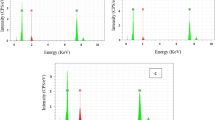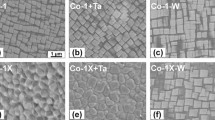Abstract
Effect of nano-grained structure on the interface behavior of pure copper in 0.01M KOH solution with chloride ion trace is investigated by various electrochemical techniques. Nano-grained structure was achieved by accumulative roll bonding (ARB) technique. Before any electrochemical measurements, microstructure was evaluated by means of optical microscopy and transmission electron microscopy (TEM). TEM observations showed that nano-grains (with an average size of below 100 nm) appeared after eight passes of ARB. Polarization curves revealed that increasing chloride ion concentration leads to a decrease in the corrosion and pitting potentials of both annealed and nano-grained pure copper samples. Electrochemical impedance spectroscopy revealed that chloride ion trace lowers passive film resistance and charge-transfer resistance in both annealed and nano-grained samples. Mott–Schottky analysis showed that the surface films formed on annealed and nano-grained samples in KOH solution with and without NaCl addition are of p-type semiconducting behavior. Moreover, this analysis showed that the acceptor density increases by increasing chloride ion concentration.









Similar content being viewed by others
References
Q. Zhong, L. Yu, Y. Xiao, Y. Wang, Q. Zhou, and Q. Zhong, The effect of grain size and Cl− concentration on the passive behavior of Cu in borate buffer solution, Adv. Mater. Res., 2013, 785, p 928–932
S.H. Sanad and A.R. Taman, Corrosion inhibition of copper and carbon steel in white petroleum oil, Surf. Tech., 1984, 23, p 159–166
A. Nikfahm, I. Danaee, A. Ashrafi, and M.R. Toroghinejad, Effect of grain size changes on corrosion behavior of copper produced by accumulative roll bonding process, Mater. Res., 2013, 16, p 1379–1386
M. Pourbaix, Atlas of Electrochemical Equilibria in Aqueous Solutions, 2nd ed., NACE, Houston, 1974
R.M. Souto, S. Gonzalez, R.C. Salvarezza, and A.J. Arvia, Kinetics of copper passivation and pitting corrosion in Na2SO4 containing dilute NaOH aqueous solution, Electrochim. Acta, 1994, 39, p 2619–2628
M. Pérez, M. Sánchez, S. Barrera, R.M. González, R.C. Souto, and A.J. Salvarezza, Arvia, electrochemical behaviour of copper in aqueous moderate alkaline media, containing sodium carbonate and bicarbonate, and sodium perchlorate, Electrochim. Acta, 1990, 35, p 1337–1343
M.M. Laz, R.M. Souto, S. González, R.C. Salvarezza, and A.J. Arvia, The formation of anodic layers on annealed copper surfaces in phosphate-containing solutions at different pH, Electrochim. Acta, 1992, 37, p 655–663
A. Fattah-alhosseini and O. Imantalab, Effect of accumulative roll bonding process on the electrochemical behavior of pure copper, J. Alloys Compd., 2015, 632, p 48–52
O. Imantalab and A. Fattah-alhosseini, Electrochemical and passive behaviors of pure copper fabricated by accumulative roll-bonding (ARB) process, J. Mater. Eng. Perform., 2015, 24, p 2579–2585
K.D. Rolstan and N. Bribilis, Effect of grain size on corrosion: a review, Corrosion, 2010, 66, p 075005–075005–075005–075013
B.V. Mahesh and R.K. Singh Raman, Role of nanostructure in electrochemical corrosion and high temperature oxidation: a review, Metall. Mater. Trans. A, 2014, 45A, p 5799–5822
J.K. Yu, E.H. Han, L. Lu, and X.J. Wei, Corrosion behaviors of nanocrystalline and conventional polycrystalline copper, J. Mater. Sci., 2005, 40, p 1019–1022
S. Tao and D.Y. Li, Tribological, mechanical and electrochemical properties of nanocrystalline copper deposits produced by pulse electrodeposition, Nanotechnology, 2006, 17, p 65–78
P. Shi, Q. Wang, Y. Xu, and W. Luo, Corrosion behavior of bulk nanocrystalline copper in ammonia solution, Mater. Lett., 2011, 65, p 857–859
M. Shaarbaf and M.R. Toroghinejad, Nano-grained copper strip produced by accumulative roll bonding process, Mater. Sci. Eng., A, 2008, 473, p 28–33
Y. Ashworth and D. Fairhurst, The anodic formation of Cu2 O in alkaline solutions, J. Electrochem. Soc., 1977, 124, p 506–517
R.M. Souto, S. Gonzalez, R.C. Salvarezza, and A.J. Arvia, Kinetics of copper passivation and pitting corrosion in Na2SO4 containing dilute NaOH aqueous solution, Electrochim. Acta, 1994, 39, p 2619–2628
M. Pérez, M. Sánchez, S. Barrera, R.M. González, R.C. Souto, and A.J. Salvarezza, Arvia, Electrochemical behaviour of copper in aqueous moderate alkaline media, containing sodium carbonate and bicarbonate, and sodium perchlorate, Electrochim. Acta, 1990, 35, p 1337–1343
M.M. Laz, R.M. Souto, S. González, R.C. Salvarezza, and A.J. Arvia, The formation of anodic layers on annealed copper surfaces in phosphate-containing solutions at different pH, Electrochim. Acta, 1992, 37, p 655–663
L. Liu, Y. Li, and F. Wang, Influence of nanocrystallization on passive behavior of Ni-based superalloy in acidic solutions, Electrochim. Acta, 2007, 52, p 2392–2400
C.Y. Chao, L.F. Lin, and D.D. Macdonald, A point defect model for anodic passive films II. Chemical breakdown and pit initiation, J. Electrochem. Soc., 1981, 128, p 1194–1198
S. Yang and D.D. Macdonald, Theoretical and experimental studies of the pitting of type 316L stainless steel in borate buffer solution containing nitrate ion, Electrochim. Acta, 2007, 52, p 1871–1879
M. Urquidi and D.D. Macdonald, Solute–vacancy interaction model and the effect of minor alloying elements on the initiation of pitting corrosion, J. Electrochem. Soc., 1985, 132, p 555–558
S.J. Ahn, H.S. Kwon, and D.D. Macdonald, Role of chloride ion in passivity breakdown on iron and nickel, J. Electrochem. Soc., 2005, 152, p B482–B490
Author information
Authors and Affiliations
Corresponding author
Rights and permissions
About this article
Cite this article
Fattah-Alhosseini, A., Imantalab, O. & Attarzadeh, F.R. Electrochemical Behavior of Nano-grained Pure Copper in Dilute Alkaline Solution with Chloride Ion Trace. J. of Materi Eng and Perform 25, 4478–4483 (2016). https://doi.org/10.1007/s11665-016-2309-8
Received:
Revised:
Published:
Issue Date:
DOI: https://doi.org/10.1007/s11665-016-2309-8




